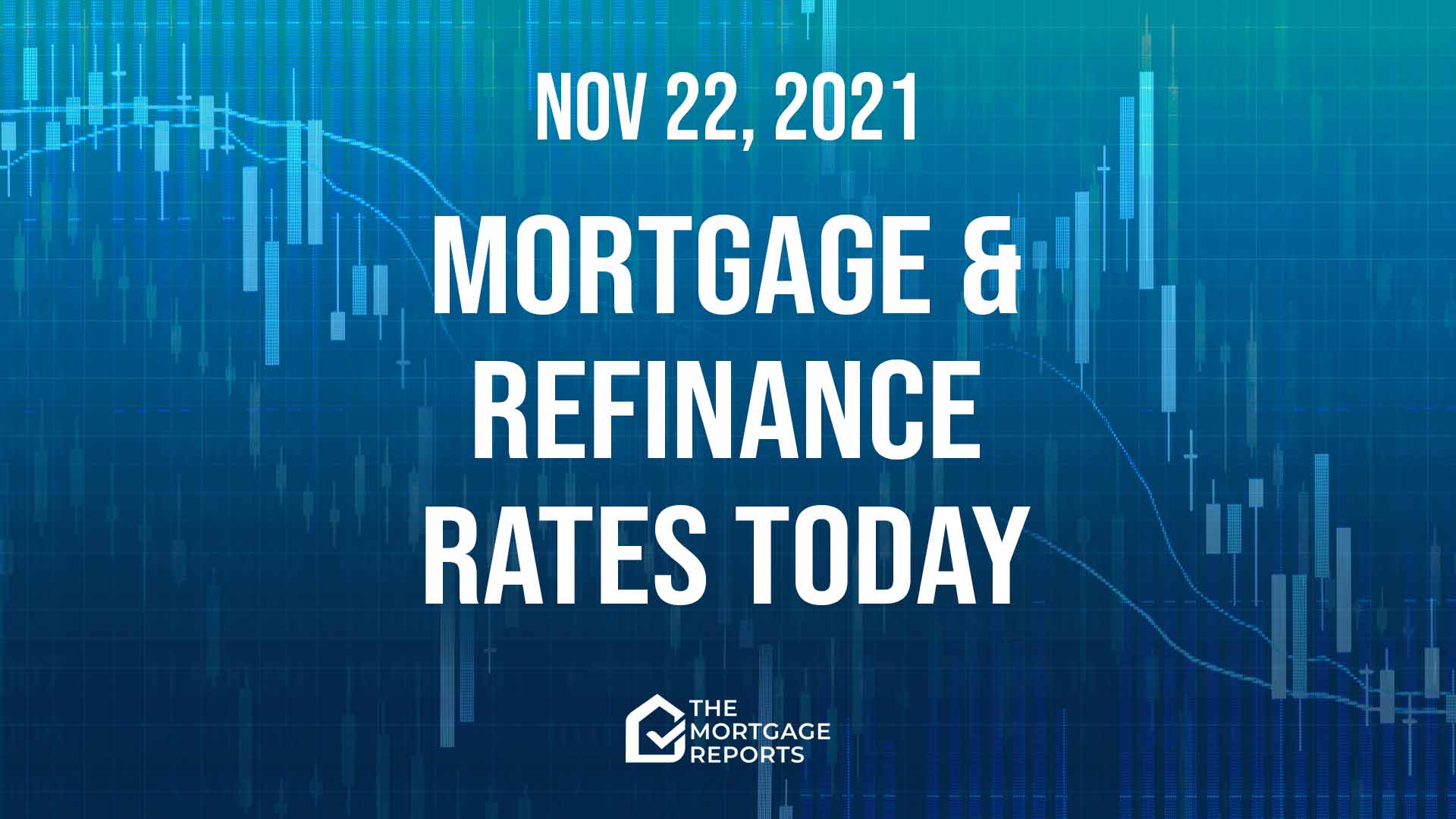
Today’s mortgage and refinance rates
Average mortgage rates fell last Friday. And by a worthwhile amount. Indeed, the last three business days have dragged those rates down from a recent high to somewhere more comfortable.
There were signs in markets earlier that mortgage rates today might bounce back higher. President Joe Biden announced at about 9 a.m. (ET) that Jerome Powell would retain his role as Federal Reserve chair. And that might create more volatility as investors digest the news.
Find your lowest rate. Start here (Nov 22nd, 2021)Current mortgage and refinance rates
| Program | Mortgage Rate | APR* | Change |
|---|---|---|---|
| Conventional 30 year fixed | |||
| Conventional 30 year fixed | 3.262% | 3.28% | Unchanged |
| Conventional 15 year fixed | |||
| Conventional 15 year fixed | 2.671% | 2.701% | Unchanged |
| Conventional 20 year fixed | |||
| Conventional 20 year fixed | 3.108% | 3.143% | Unchanged |
| Conventional 10 year fixed | |||
| Conventional 10 year fixed | 2.66% | 2.718% | Unchanged |
| 30 year fixed FHA | |||
| 30 year fixed FHA | 3.294% | 4.058% | Unchanged |
| 15 year fixed FHA | |||
| 15 year fixed FHA | 2.614% | 3.259% | Unchanged |
| 5/1 ARM FHA | |||
| 5/1 ARM FHA | 2.383% | 3.125% | +0.01% |
| 30 year fixed VA | |||
| 30 year fixed VA | 2.869% | 3.055% | Unchanged |
| 15 year fixed VA | |||
| 15 year fixed VA | 2.745% | 3.087% | Unchanged |
| 5/1 ARM VA | |||
| 5/1 ARM VA | 2.501% | 2.373% | +0.01% |
| Rates are provided by our partner network, and may not reflect the market. Your rate might be different. Click here for a personalized rate quote. See our rate assumptions here. | |||
Should you lock a mortgage rate today?
A recent resurgence in COVID-19 rates in Europe is forcing me to rethink my personal rate lock recommendations, especially as we seem to be seeing the start of a similar trend here. However, I need more data before I make any hasty changes.
So, for now, those recommendations remain:
- LOCK if closing in 7 days
- LOCK if closing in 15 days
- LOCK if closing in 30 days
- LOCK if closing in 45 days
- LOCK if closing in 60 days
>Related: 7 Tips to get the best refinance rate
Market data affecting today’s mortgage rates
Here’s a snapshot of the state of play this morning at about 9:50 a.m. (ET). The data, compared with roughly the same time last Friday, were:
- The yield on 10-year Treasury notes climbed to 1.58% from 1.53%. (Bad for mortgage rates.) More than any other market, mortgage rates normally tend to follow these particular Treasury bond yields
- Major stock indexes were mostly higher soon after opening. (Bad for mortgage rates.) When investors are buying shares they’re often selling bonds, which pushes prices of those down and increases yields and mortgage rates. The opposite may happen when indexes are lower. But this is an imperfect relationship
- Oil prices fell to $76.13 from $77.04 a barrel. (Good for mortgage rates*.) Energy prices play a large role in creating inflation and also point to future economic activity.
- Gold prices fell to $1,818 from $1,863 an ounce. (Bad for mortgage rates*.) In general, it is better for rates when gold rises, and worse when gold falls. Gold tends to rise when investors worry about the economy. And worried investors tend to push rates lower
- CNN Business Fear & Greed index — edged down to 71 from 74 out of 100. (Good for mortgage rates.) “Greedy” investors push bond prices down (and interest rates up) as they leave the bond market and move into stocks, while “fearful” investors do the opposite. So lower readings are better than higher ones
Caveats about markets and rates
Before the pandemic and the Federal Reserve’s interventions in the mortgage market, you could look at the above figures and make a pretty good guess about what would happen to mortgage rates that day. But that’s no longer the case. We still make daily calls. And are usually right. But our record for accuracy won’t achieve their former high levels until things settle down.
So use markets only as a rough guide. Because they have to be exceptionally strong or weak to rely on them. But, with that caveat, mortgage rates today look likely to rise. But be aware that “intraday swings” (when rates change direction during the day) are a common feature right now.
Find your lowest rate. Start here (Nov 22nd, 2021)Important notes on today’s mortgage rates
Here are some things you need to know:
- Typically, mortgage rates go up when the economy’s doing well and down when it’s in trouble. But there are exceptions. Read ‘How mortgage rates are determined and why you should care
- Only “top-tier” borrowers (with stellar credit scores, big down payments and very healthy finances) get the ultralow mortgage rates you’ll see advertised
- Lenders vary. Yours may or may not follow the crowd when it comes to daily rate movements — though they all usually follow the wider trend over time
- When daily rate changes are small, some lenders will adjust closing costs and leave their rate cards the same
- Refinance rates are typically close to those for purchases. And a recent regulatory change has narrowed a gap that previously existed
So a lot is going on here. And nobody can claim to know with certainty what’s going to happen to mortgage rates in coming hours, days, weeks or months.
Are mortgage and refinance rates rising or falling?
Every force that’s currently trying to push mortgage rates higher has its roots in the COVID-19 pandemic. Indeed, you could, last year, have said the same about the forces then trying to pull those rates lower.
So a resurgence in the pandemic could change everything. It could pull inflation down, force the Fed to regrow its support for artificially low mortgage rates and cripple the economic recovery.
Resurging COVID-19?
And just such a resurgence is happening on the other side of the Atlantic. As The New York Times put it yesterday:
Europe is experiencing a menacing fourth wave of the coronavirus, with soaring rates of infection. While Austria may be the first European country to respond with a nationwide lockdown, it may not be the last.
— NYT, “Angry and Divided, Austrians Argue Over a Lockdown and Vaccine Mandates,” Nov. 21, 2021
If a similar new wave hits America, we could see economic problems. And just such a new wave may be beginning to emerge here.
On Jan. 6, COVID-19 reached an all-time high of 301,000 daily infections in the United States. Then those slumped but climbed back to another high of 285,000 on Sept. 13. After that, they fell again, reaching 70,000 on Oct. 25. But, since then, they’ve been moving upward, hitting 94,000 yesterday. That’s up 29% over the last 14 days.
All those figures came from The New York Times, which has a general paywall. However, at one point it gave universal and free access to COVID-19 stories and data. And it may still do. So try clicking those links for more background, even if you aren’t a subscriber.
Lower mortgage rates ahead?
It feels a long time since I’ve been able to ask whether we might soon see lower mortgage rates. But they’re a real possibility if we do get a new and serious coronavirus wave here.
However, those lower rates are just that: a possibility. For now, we don’t know how bad a new wave will get. Nor how much economic damage it will wreak.
Many more Americans (59%) are vaccinated this year than last. So we may witness fewer hospitalizations and deaths, which may allow less strict — or no — lockdowns.
Uncertainty
But that’s far from certain. Vaccination rates in Europe tend to be way higher than in the US. For example, 87.6% of French people over the age of 12 have been fully vaccinated. But it’s Europe that’s currently struggling to contain infection rates.
All these unknowns mean I’m not yet ready to change my advice over mortgage rates. If they fall at all, it will likely be only for the winter, after which they’ll probably resume their upward trend. And it’s far from certain that they will fall at all.
But I’m now wondering if they will. And that means you should be, too.
Read last Saturday’s weekend edition for more background.
Recently
Over much of 2020, the overall trend for mortgage rates was clearly downward. And a new, weekly all-time low was set on 16 occasions last year, according to Freddie Mac.
The most recent weekly record low occurred on Jan. 7, when it stood at 2.65% for 30-year fixed-rate mortgages.
Since then, the picture has been mixed with extended periods of rises and falls. Unfortunately, since September, the rises have grown more pronounced, though not consistently so.
Freddie’s Nov. 17 report puts that weekly average for 30-year, fixed-rate mortgages at 3.1% (with 0.7 fees and points), up from the previous week’s 2.98%.
Expert mortgage rate forecasts
Looking further ahead, Fannie Mae, Freddie Mac and the Mortgage Bankers Association (MBA) each has a team of economists dedicated to monitoring and forecasting what will happen to the economy, the housing sector and mortgage rates.
And here are their current rate forecasts for the remaining, current quarter of 2021 (Q4/21) and the first three quarters of 2022 (Q1/22, Q2/22 and Q3/22).
The numbers in the table below are for 30-year, fixed-rate mortgages. Fannie’s were published on Nov. 18, Freddie’s on Oct. 15 and the MBA’s on Oct. 18.
| Forecaster | Q4/21 | Q1/22 | Q2/22 | Q3/22 |
| Fannie Mae | 3.1% | 3.2% | 3.3% | 3.3% |
| Freddie Mac | 3.2% | 3.4% | 3.5% | 3.6% |
| MBA | 3.1% | 3.3% | 3.5% | 3.7% |
However, given so many unknowables, the whole current crop of forecasts may be even more speculative than usual.
All these forecasts expect at least modestly higher mortgage rates fairly soon.
Find your lowest rate today
Some lenders have been spooked by the pandemic. And they’re restricting their offerings to just the most vanilla-flavored mortgages and refinances.
But others remain brave. And you can still probably find the cash-out refinance, investment mortgage or jumbo loan you want. You just have to shop around more widely.
But, of course, you should be comparison shopping widely, no matter what sort of mortgage you want. As federal regulator the Consumer Financial Protection Bureau says:
Shopping around for your mortgage has the potential to lead to real savings. It may not sound like much, but saving even a quarter of a point in interest on your mortgage saves you thousands of dollars over the life of your loan.
Verify your new rate (Nov 22nd, 2021)Mortgage rate methodology



